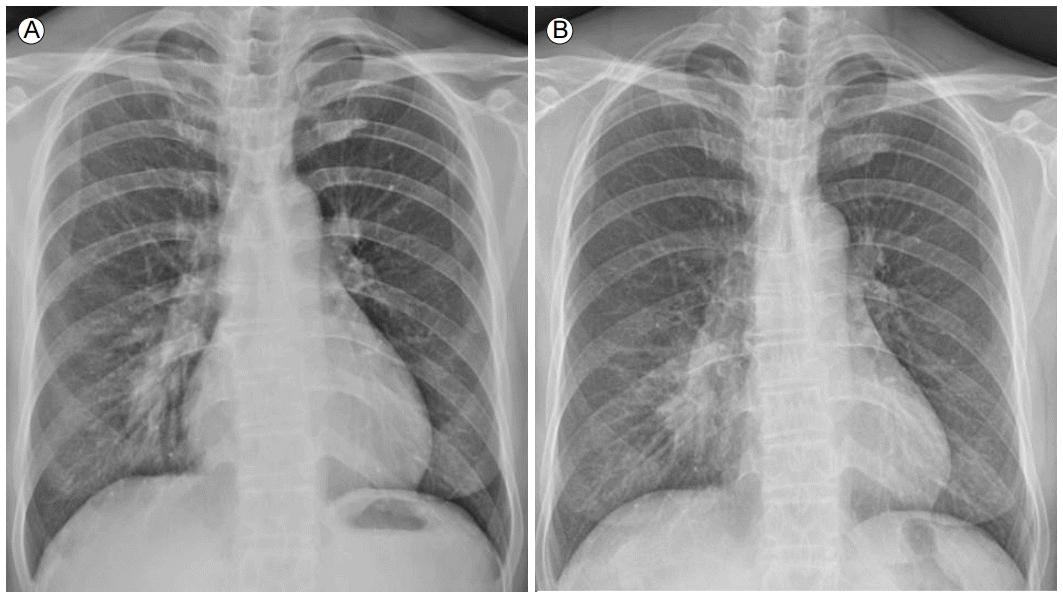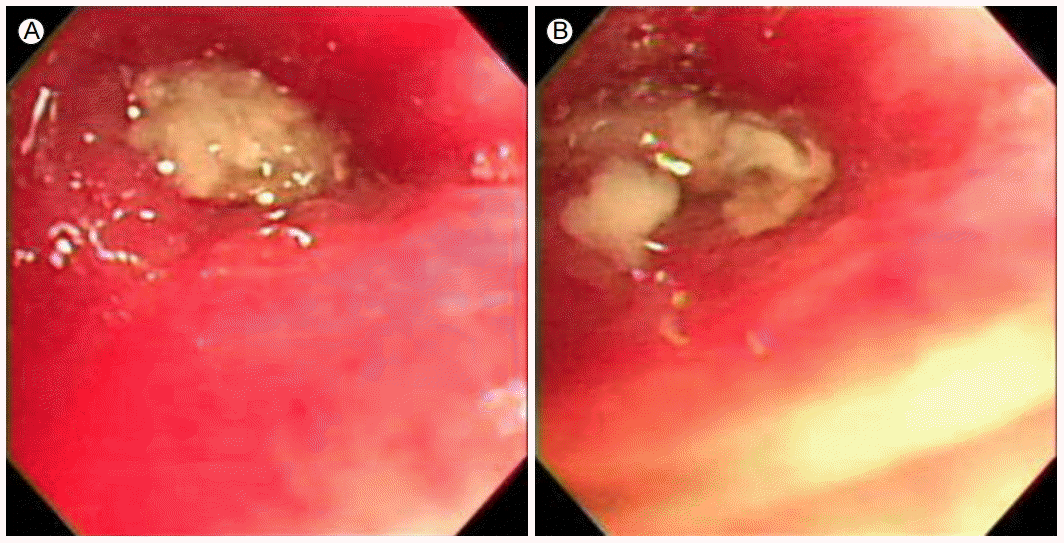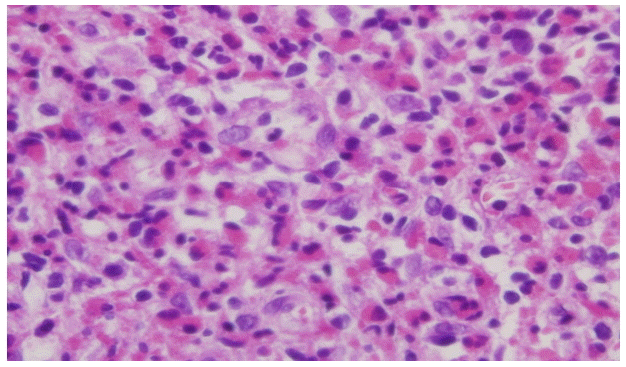원인 미상의 호산구성 기관지내 점액박힘에 의한 폐쇄성 폐렴 1예
Obstructive Pneumonia due to Unknown Eosinophilic Mucoid Impaction of Bronchi: a Case Report
Article information
Trans Abstract
We report an unusual case of obstructive pneumonia due to an unknown eosinophilic mucoid impaction of the bronchi (MIB). A 54-year-old woman visited our hospital for investigation of abnormal shadows visible on a chest radiograph. Chest computed tomography and bronchoscopic examination revealed pneumonia due to MIB. Histopathological examination of biopsied mucosal tissue revealed extensive eosinophilic infiltration. With the exclusion of medical diseases that can cause eosinophilia, pneumonia due to eosinophilic mucoid impaction of the bronchi was diagnosed. The cause of the eosinophilia remained unknown. The pneumonia and mucoid impaction resolved after oral steroid therapy.
INTRODUCTION
Mucoid impaction of the bronchi (MIB) is a clinicopathological syndrome that is manifested as obstructive mucous plugs in the dilated bronchi [1]. Although there have been several reports of MIB occurring distal to obstructive endobronchial lesions, such as tumors and atresia [2], it is believed that it occurs most commonly as a manifestation of hypersensitivity in patients with bronchial asthma or in association with allergic bronchopulmonary aspergillosis (ABPA).
In this report, we describe the case of a patient with peripheral eosinophilia and MIB caused by eosinophilic infiltration, without any secondary cause. The patient’s condition improved with prednisolone administration. This case of MIB is rare in that it was caused by eosinophilic infiltration alone; thus, we believe the case is worth reporting.
CASE REPORT
A 54-year-old woman was referred to Wonkwang University Hospital for investigation of an abnormal chest radiograph. The patient had a 4-week history of productive cough and rhinorrhea. She had been diagnosed with pneumonia (Fig. 1A) at a private clinic and had undergone medical treatment for it. There was no history of hemoptysis, anorexia, or weight loss. Her medical history was unremarkable and she denied any history of drug use. In the private clinic where she had been treated, oral antibiotic (cephalosporin) had been administered for 2 weeks, with resolution of some symptoms; however, she had a non-resolving radiological infiltrate.

Chest X-ray showing increased focal opacity with obliteration of the right lower cardiac border at the private clinic (A) and at our hospital (B).
Blood tests revealed peripheral eosinophilia (white blood cell count, 6,800/mm3 with 16.2% eosinophils). IgE and C-reactive protein levels were within the reference range. The chest radiograph showed pneumonic consolidation in the right middle lung (RML) (Fig. 1B). Computed tomography (CT) of the chest revealed a peribronchial distribution of the consolidative lesion and bronchial obliteration with low-attenuation material in the RML (Fig. 2). To identify the endobronchial lesion, we performed a bronchoscopy. Thick, white mucous plugs were observed in the RML bronchus, causing total obstruction (Fig. 3) that could not be removed by suctioning or the use of forceps. A bronchoscopic biopsy of the abnormal mucosal surface and mucous plugs was performed. Histopathological examination of the biopsied mucosal tissue revealed extensive eosinophilic infiltration (Fig. 4). No common bacteria or fungi were identified, and cytology of the bronchoscopic specimens was negative. The smear and culture tests for acid-fast bacilli were negative, as were the results of polymerase chain reaction for the detection of Mycobacterium tuberculosis.

Chest CT showing peribronchial distribution of the consolidative lesion and bronchial obliteration with low-attenuation material in the right middle lung. CT, computed tomography.

Bronchoscopy showed thick white mucous plugs causing total obstruction in the right middle lobe bronchus.

Histopathological examination of the mucosal plug revealed extensive eosinophilic infiltration (hematoxylin and eosin stain, ×1,000).
We performed several diagnostic tests to rule out secondary causes for the eosinophilic mucoid impaction of the bronchi. The results of enzyme-linked immunosorbent assays (ELISAs) for the detection of infectious parasites (such as Clonorchis, Paragonimus, and cysticerci and spargana of tapeworms such as Taenia solium) were all negative. To rule out allergic bronchopulmonary aspergillosis, we performed Aspergillus fumigatus skin-prick and asthma provocation tests. The results were negative. Asthma was excluded from the diagnosis because the patient did not exhibit any of its characteristic symptoms, such as wheezing, shortness of breath, or chest tightness. Clinical and laboratory findings did not indicate vasculitis.
Because parasitic diseases and medical conditions that can cause eosinophilia, such as asthma, were ruled out, pneumonia due to unknown eosinophilic mucoid impaction of the bronchi was diagnosed. We started oral administration of 30 mg/day prednisolone and then tapered this dose for 2 weeks. We repeated the chest CT and bronchoscopy after 1 month of steroid therapy. The chest CT after treatment showed that the previously noted mucous impaction and consolidation in the RML had almost resolved (Fig. 5). Bronchoscopic examination showed that the obstruction of the RML bronchus had resolved. The patient is being followed regularly. She did not show any symptoms at the 6-month follow-up, and her physical examination yielded normal results.
DISCUSSION
Eosinophilic lung diseases are a heterogeneous group of pulmonary disorders characterized by an increased number of eosinophils in the airway or lung parenchyma. This case showed no evidence of asthma or increased IgE levels. The chest CT findings did not meet the diagnostic criteria for eosinophilic lung disease. This case was unusual because the patient had obstructive pneumonia due to eosinophilic MIB, but the underlying cause remained unknown.
MIB is a clinicopathological syndrome, manifested as obstructive mucous plugs in the dilated second- or third-order bronchi [1]. Most cases of MIB are diagnosed clinically and radiologically. The first report of MIB in 1951 described dilated bronchi filled with inspissated mucus in five patients who presented with wheezing, cough, and a history of allergy [3]. In 1957, Greer [4] used the descriptive term “cluster of grapes” to refer to the radiographic appearance of mucoid impactions in several patients with similar clinical histories. The clinical, radiological, and microbiological data in these reports suggested that these patients presented with what today would be diagnosed as allergic bronchopulmonary aspergillosis (ABPA).
Most of the causative diseases of MIB are allergic disorders such as ABPA [5,6]. However, the differential diagnosis of MIB includes a large range of causative diseases, including congenital diseases (bronchial atresia), inflammatory diseases (ABPA, status asthmaticus, and foreign body aspiration), and neoplasms [7].
In recent years, a few unusual cases of MIB have been reported. One such case was that of a patient with MIB due to Schizophyllum commune infection [8]. Despite the fact that there has been an increase in the number of reports of ABPA due to S. commune infection, the most common causative agent of ABPA is Aspergillus fumigatus. Another case was that of a patient with MIB caused by Mycobacterium avium [9].
The radiographic appearance of MIB is variable. If the affected airway is large or dilated, the mucus secretions may be visible on chest radiographs or CT images as tubular or branching opacities. These opacities, which typically radiate from the hilum towards the periphery of the lung, are classically described as the “finger-in-glove sign” [10]. When mucus and other secretions are retained in bronchioles and non-dilated airways, the radiographic appearance is normal. However, even in these cases, thin-section chest CT may show branching and tree-in-bud opacities.
In conclusion, we reported a case of MIB caused by eosinophilic infiltration and peripheral eosinophilia. We could not rule out the possibility that this was a secondary manifestation of a specific unknown disorder. However, the patient showed no evidence of underlying pulmonary disease, such as asthma, parasite or fungal infections, or neoplasm. This case was unusual in that it did not qualify as an eosinophilic lung disease but showed pneumonia due to eosinophilic MIB on radiological and histological examinations.
We report a case of a patient with peripheral eosinophilia and MIB caused by eosinophilic infiltration, with no apparent secondary cause. This case is unusual in that it did not qualify as an eosinophilic lung disease but we diagnosed pneumonia due to eosinophilic MIB based on radiological and histological examinations.
